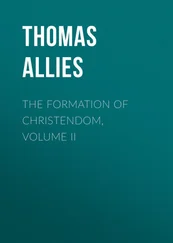Thomas Allies - Peter's Rock in Mohammed's Flood, from St. Gregory the Great to St. Leo III
Здесь есть возможность читать онлайн «Thomas Allies - Peter's Rock in Mohammed's Flood, from St. Gregory the Great to St. Leo III» — ознакомительный отрывок электронной книги совершенно бесплатно, а после прочтения отрывка купить полную версию. В некоторых случаях можно слушать аудио, скачать через торрент в формате fb2 и присутствует краткое содержание. Издательство: Иностранный паблик, Жанр: foreign_antique, foreign_prose, Историческая проза, на английском языке. Описание произведения, (предисловие) а так же отзывы посетителей доступны на портале библиотеки ЛибКат.
- Название:Peter's Rock in Mohammed's Flood, from St. Gregory the Great to St. Leo III
- Автор:
- Издательство:Иностранный паблик
- Жанр:
- Год:неизвестен
- ISBN:нет данных
- Рейтинг книги:4 / 5. Голосов: 1
-
Избранное:Добавить в избранное
- Отзывы:
-
Ваша оценка:
- 80
- 1
- 2
- 3
- 4
- 5
Peter's Rock in Mohammed's Flood, from St. Gregory the Great to St. Leo III: краткое содержание, описание и аннотация
Предлагаем к чтению аннотацию, описание, краткое содержание или предисловие (зависит от того, что написал сам автор книги «Peter's Rock in Mohammed's Flood, from St. Gregory the Great to St. Leo III»). Если вы не нашли необходимую информацию о книге — напишите в комментариях, мы постараемся отыскать её.
Peter's Rock in Mohammed's Flood, from St. Gregory the Great to St. Leo III — читать онлайн ознакомительный отрывок
Ниже представлен текст книги, разбитый по страницам. Система сохранения места последней прочитанной страницы, позволяет с удобством читать онлайн бесплатно книгу «Peter's Rock in Mohammed's Flood, from St. Gregory the Great to St. Leo III», без необходимости каждый раз заново искать на чём Вы остановились. Поставьте закладку, и сможете в любой момент перейти на страницу, на которой закончили чтение.
Интервал:
Закладка:
After this glimpse at the action of the Byzantine and Persian empires on each other during the thirty years which follow immediately on the death of St. Gregory, we turn to consider the conduct of the temporal liege-lord of the Pope towards him whom he recognised as successor of St. Peter.
The emperor Phocas, following in this his predecessor Justinian, had expressly enjoined on the patriarch of Constantinople to recognise the Primacy of Rome. What the chroniclers remark is important, that Boniface III., the next to succeed St. Gregory, received a decree from Phocas, in which he solemnly declared that the See of the Roman Church was to be considered the head of Christendom. It may be remarked here that Phocas did not say a word more than his predecessor, Marcian, said to St. Leo a hundred and fifty years before. Phocas may be named a tyrant, but Marcian has left an unspotted reputation as a Christian king and Roman prince, who received the empire with the hand of Pulcheria, heiress of the great Theodosius, and the only descendant worthy of his greatness, whose name stands also on the diptychs of the Catholic Church as a virgin saint.
Upon the history of the City of Rome during the first half of the seventh century the greatest obscurity rests. It was indeed the most frightful and destructive century for the former queen-city of the world. The Book of the Popes by Anastasius trickles in a slender thread amid war, famine, and pestilence, and inundations of the Tiber; but it is all we have to look at.
With the death of the great Pontiff, who guarded and fed his city while the calamities which he saw all round the sphere of his vision over the whole Church led him to look for the end of the world, the See of Peter remained half a year unfilled until his successor, Sabinianus of Volterra, formerly Papal Nuncio at the Byzantine court, received the confirmation of his election from the exarch or the emperor. The confirmation of each pope's election was, as a rule, obtained either from the exarch or direct from the emperor. It was a business both costly and protracted. It also made the spiritual head of Rome dependent for his recognition on the imperial court. I find that in the period of 111 years, running from the death of St. Gregory in 604 to the death of Pope Constantine in 715, twenty-four popes succeeded. Of these the first, Sabinian, in 604, had to wait six months. Phocas confirmed the election of Boniface III., the next pope, after a year. He died in November, 607, and Boniface IV. following took his seat in August, 608. When he died, Pope Deusdedit waited five months. At his death Boniface V. succeeded after a year, in 619. Pope Honorius followed Boniface in five days and sat during thirteen years, but at his death the confirmation of his successor, Pope Severinus, was delayed by Greek intrigue, and for a purpose hereafter to be mentioned, during nineteen months and sixteen days, so that he only sat from the 28th May to the 1st August, 640. St. Martin in 649 did not wait for the imperial confirmation; he was first banished and then martyred by the emperor Constans II., who put in by threats his successor, Eugenius, during his lifetime. St. Leo II. waited eighteen months in 682, after the death of Pope Agatho, and the next Pope, Benedict II., a year in 684.
This privation of its original freedom, according to which the Pope's consecration followed at once upon his complete and legitimate election by clergy and people, the Roman Church owed to the Arian Herule Odoacer, during his occupation of Italy. It was eagerly grasped, after Theodorich and Theodatus had exercised it, by Justinian, when he became, by conquest, lord of Rome. I have already recorded the infamous violence exerted by Belisarius as soon as he had entered Rome, at the bidding of the Empress Theodora, upon St. Silverius. Now we have the eastern emperors, through the seventh century, exerting, sometimes directly, sometimes by delegation to their exarch, this stolen privilege. It was taken by Odoacer ostensibly for the preservation of order in the election, and the prevention of violence. I suppose it is the furthest reach of disloyalty to exercise a power which has been entrusted for protection to the injury of the party protected. This disloyalty was perpetually shown by the eastern emperors to the Popes, whose Primacy over the Church they acknowledged, until they finally lost the opportunity by the new-creation of the Western empire, and the acquisition of temporal sovereignty by the Popes.
At the accession of Honorius I., in 625, it is stated to have been the custom, upon the death of a Pope, that the Archpriest, the Archdeacon, and the first of the Notaries signified his death to the exarch. The Acts of the new election, subscribed by clergy and laity, were deposited in the archives of the Lateran. A copy of them was sent to the emperor. The report sent to the exarch was the more important. This Viceroy of Italy was humbly besought for his consent: nay, even the Archbishop and Judges of Ravenna were asked to obtain it from him. The clergy and people of Rome had to look to the exarch, the emperor's delegate, even more than to the emperor, since he stood in more immediate relation to Rome, and determined the decision of the Byzantine court. The Romans, suffering from the delay of their bishop's consecration, would entreat the emperor to lessen the time of disturbance by allowing the exarch to confirm their choice.
In the short pontificates of the Popes, who sat from St. Gregory to Honorius, we may note one remarkable fact. Full six centuries after its erection by Agrippa, as the vestibule of his baths in the centre of the Campus Martius, stood what was called the Pantheon, with its superb portico of granite pillars and white marble capitals, untouched in their beauty – the fairest relic of ancient Rome. It had withstood all the inundations of the Tiber: all the devastations of the Gothic war: all the injuries of time. Every winter the floods forced themselves up over its floor: day and night the dome, through its aperture, received the waters of heaven. The images of Augustus and Agrippa probably stood still in their niches: the beams of gilded brass supported its roof, covered with the gilt tiles of bronze, which neither Vandal, nor Goth, nor Byzantine robber had yet carried away. Pliny had given it the name of Pantheon: Dio Cassius had seen in it the statues of Mars and Venus, and of the deified Cæsars. A tablet of the Fratres Arvales has been found, dating from the year 59, in Nero's time, and showing that worship to the pagan gods was then offered in it.
Pope Boniface IV. beheld this wonder of ancient art, and longed to make a church of that beautiful dome which hung like the vault of heaven over the broadest expanse ever covered by a roof. He asked it of the emperor Phocas, and received it as a gift. He assembled the clergy of Rome, and a procession, singing hymns, entered that noble doorway, and the Pope sprinkled with holy water the marble-encrusted walls, from which every vestige of heathendom was cleared away. The “Gloria in Excelsis” resounded for the first time in that dome from which Michael Angelo took his most beautiful creation. The temple of all the demons was purified: and Pope Boniface IV. preserved it for all succeeding ages, under its dedication to the Ever-virgin Mother of God, and all martyrs. So it was saved from becoming, in mediæval times, the hold of some noble robber. And from it the devotion to All Saints, on the 1st November, and for All Souls, on the 2nd, was propagated amongst the nations of the West. What was originally a Roman festival passed beyond the Alps and the dome of Agrippa, the partner of Augustus and the husband of Julia, and through her progenitor of Cæsars, became the shrine from which the glorious office of all the saints in the Church triumphant, and that of intercession for all souls in the Church suffering, went forth to the Christian world.
Читать дальшеИнтервал:
Закладка:
Похожие книги на «Peter's Rock in Mohammed's Flood, from St. Gregory the Great to St. Leo III»
Представляем Вашему вниманию похожие книги на «Peter's Rock in Mohammed's Flood, from St. Gregory the Great to St. Leo III» списком для выбора. Мы отобрали схожую по названию и смыслу литературу в надежде предоставить читателям больше вариантов отыскать новые, интересные, ещё непрочитанные произведения.
Обсуждение, отзывы о книге «Peter's Rock in Mohammed's Flood, from St. Gregory the Great to St. Leo III» и просто собственные мнения читателей. Оставьте ваши комментарии, напишите, что Вы думаете о произведении, его смысле или главных героях. Укажите что конкретно понравилось, а что нет, и почему Вы так считаете.












